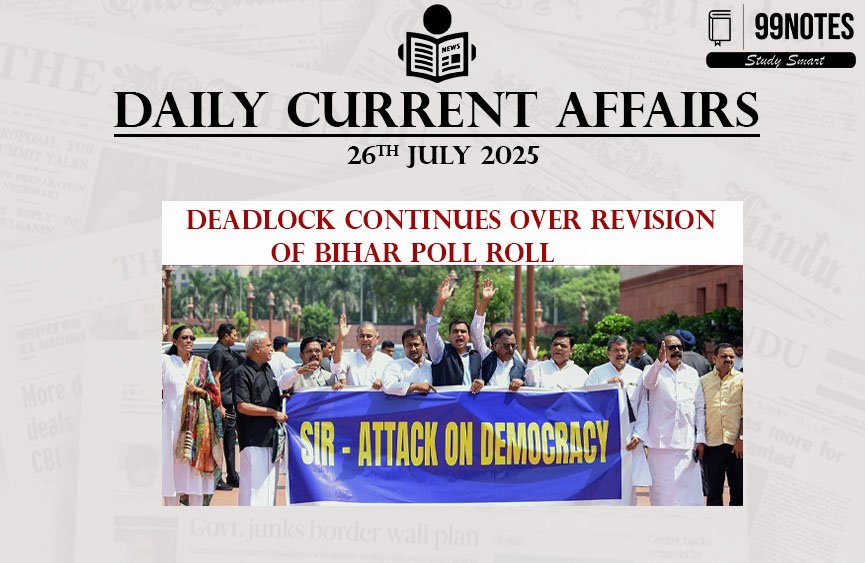26 July 2025 : Daily Current Affairs
1. Deadlock Continues over Revision of Bihar Poll Roll
Source: Page 9 , The Hindu UPSC IAS Edition
| Topic: GS-2 (Polity & Governance), GS1 (Society) |
| Context |
|
Content
Key Points:
-
The Special Intensive Revision seeks to update Bihar’s electoral rolls ahead of upcoming State elections.
-
Opposition: Accuse BJP of using SIR and Election Commission (EC) as tools for voter suppression, especially among weaker sections (“vote bandi”).
-
Protest Actions: INDIA bloc leaders, including Rahul Gandhi and Mallikarjun Kharge, conducted symbolic protests; posters were torn and disposed in bins to represent rejection of SIR.
-
Government Stand: Cites precedence and EC autonomy, questioning under what rule the debate can be held in Parliament.
-
EC data: Around 66 lakh voters may be left out of the new draft roll to be published on August 1 due to deceased status, migration, or duplication.
-
The issue has been challenged in the Supreme Court, highlighting ongoing legal and constitutional contestation.
-
Political Significance: Seen as a back-door move towards a National Register of Citizens (NRC)-like exercise; could set precedents for other states.
Analysis:
-
Tests democratic inclusivity and transparency in India’s electoral processes.
-
Brings out the tension between EC’s independent mandate and political-cum-legal accountability.
-
Raises questions about the right to vote (constitutional guarantee) and fear of disenfranchisement.
Way Forward:
-
Need for transparent mechanisms in voter roll management, with robust grievance redressal.
-
Special care to protect voting rights of marginalized groups.
-
Parliamentary debate and judicial review essential to allay public fears and ensure electoral trust.
Practice Question:
|
“Critically analyze the political and constitutional implications of the recent Special Intensive Revision of electoral rolls in Bihar. How can the independence of the Election Commission be safeguarded while ensuring the inclusivity of the electoral process?” (250 words / 15 marks) |
2. Centre Flags ‘Harsh’ Penalties for Rape; Governor Returns Aparajita Bill to Bengal Govt.
Source: page 4, The Hindu UPSC IAS Edition
| Topic: GS-2 (Polity & Governance), GS4 (Ethics, Judiciary) |
| Context |
|
Analysis from UPSC Angle:
Key Points:
-
The Aparajita Bill proposes to make death penalty mandatory or life imprisonment for rape leading to death or vegetative state, and other aggravated sexual offenses.
-
The Ministry of Home Affairs (MHA) flagged the removal of judicial discretion and proportionality in sentencing, terming the measure “excessively harsh and disproportionate.”
-
Concerns also raised about removing the age distinction in punishment for rape of girls under 16 and 12.
-
Legislative Context: The Bill was passed after the heinous rape and murder of a doctor in Kolkata (2024), indicative of a strong public response to crimes against women.
-
Legal Debate: Dilemma over deterrence versus human rights and due process; possible violation of international conventions against mandatory death penalty.
-
Current Status: Bill returned to State for reconsideration; appeals from state government for central approval.
Analysis:
-
Reflects the balance between deterrence and proportional justice, core ethical dilemmas in criminal law.
-
Removal of judicial discretion undermines the principle of individualized justice and the right to a fair trial.
-
Highlights federal tensions: State legislative activism vs. Central government oversight.
Way Forward:
-
Broader debate on proportionality in sentencing, with due consideration to Supreme Court guidelines (e.g., Bachan Singh vs. State of Punjab).
-
Focus on speedy trials, victim protection, rather than populist punitive escalation.
-
Need for comprehensive criminal justice reforms, including police and judiciary, for effective justice delivery.
Practice Question:
|
“Discuss the constitutional and ethical dimensions involved in prescribing mandatory death penalty for certain offenses. Should judicial discretion in sentencing be curtailed in cases of heinous crimes? Critically examine with reference to recent legislative actions in India.” (250 words / 15 marks) |
3. Mangroves — From Margins to Mainstream in Climate Adaptation
Source: Page 6, Indian Express Delhi Edition
| Topic: GS-3 (Environment), GS1 (Geography), GS2 (Governance) |
| Context |
|
Key Points for UPSC:
Key Points:
-
Mangroves in India have moved from “marshy land” to vital coastal ecosystems.
-
Serve as disaster buffers, enhance fisheries, store atmospheric carbon, and promote biodiversity.
-
India’s mangrove cover: 4,991.68km² (as per ISFR 2023), with an increase of 16.68km² since 2019.
-
National and international advocacy (by M.S. Swaminathan, ISME, GLOMIS) linked ecological restoration to food and livelihood security.
-
Participatory management and scientific restoration strategies (like the fishbone canal method) have reversed degradation in many areas.
-
Policy integration: Mangroves now central to India’s climate change adaptation, disaster risk reduction, and sustainable development policy.
Analysis:
-
Mangroves as a model for leveraging traditional knowledge, participatory governance, and scientific innovation in environmental policy.
-
Their restoration exemplifies the linkage between environment, economics, and social equity.
-
Ongoing risks: industrial encroachment, climate-induced sea level rise, weak regulatory enforcement.
Way Forward:
-
Strengthen community-based management, integrate mangroves with coastal urban planning.
-
Enhance cross-state and international cooperation for genetic resource conservation.
-
Promote science-based restoration and afforestation initiatives.
Practice Question:
|
“Explain the significance of mangrove ecosystems for climate change adaptation and disaster risk reduction in India. What lessons can be drawn from India’s mangrove restoration experience for sustainable coastal management?” (150 words / 10 marks) |
Check more: 25 July 2025 : Daily Current Affairs

